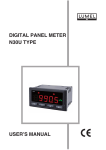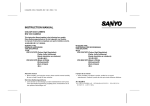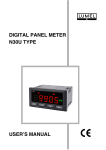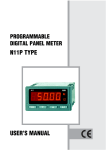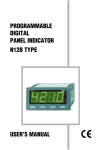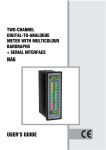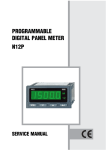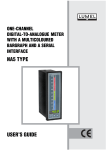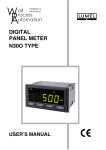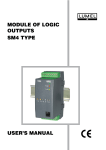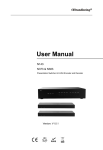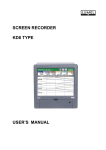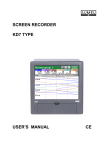Download programmable digital panel meter n12 type user`s manual
Transcript
PROGRAMMABLE DIGITAL PANEL METER N12 TYPE USERS MANUAL PROGRAMMABLE DIGITAL PANEL METER N12 TYPE CONTENTS Page 1. APPLICATION ..................................................................... 5 2. BASIC REQUIREMENTS, OPERATIONAL SAFETY ......... 6 3. FITTING ............................................................................... 7 4. CONNECTION ..................................................................... 8 5. OPERATION . ................................................................... 10 6. PROGRAMMING ............................................................... 14 7. RS-485 INTERFACE ......................................................... 24 7.1. Connection way of the serial interface ...................... 25 7.2. Description of the MODBUS protocol implementation ... 26 7.3. Description of used functions .................................... 26 7.4. Register map of the N12 meter ................................. 28 7.5. Registers of writing and reading ................................ 29 7.6. Registers for reading ................................................. 42 8. TECHNICAL DATA. ........................................................... 45 9. BEFORE A FAILURE WILL BE DECLARED .................... 50 10. PROGRAMMING EXAMPLES OF N12 METERS ............ 53 11. EXECUTION CODES ........................................................ 56 12. MAINTENANCE AND GUARANTEE ................................ 57 ! " 1. APPLICATION N12 programmable digital panel meters of S, H and T executions are destined to measure d.c. voltages and d.c. currents, temperature, resistance and other quantities converted into electrical signals. A 5 or 4-digit display field (14 or 20mm heigh digits, in red or green colour ensures a good legibility at a long distance. They realized other additional functions as: l signalling the set alarm value exceeding, l signalling the measuring range exceeding, l counting of the measuring quantity into any optional quantity on the base of individual, linear characteristic, l programmable indication resolution, l programmable measurement repetition rate, l storage of maximal and minimal values, l monitoring of set parameter values, l blocking the parameter introduction by means of a password, l conversion of the measured quantity into a standard programmable current or voltage signal, l supply two-wire object transducers (24 V), in the N12S execution, l highlighting any optional measuring unit as per the order. l handling the RS-485 in the MODBUS protocole, both ASCII and RTU. With the meter we deliver: - a guarantee certificate, - 2 holders to fix the meter on a panel, - a service manual, - a connector with screw connections or self-locking connections, - a set of stickers with units. When unpacking the meter, please check whether the type and execution code on the data plate correspond to the order. # Symbols located in this service manual mean: ! - especially important, one must be familiar with this before connecting the meter ? - one must take note of this when the meter is working inconsistently to the expectations 2. BASIC REQUIREMENTS, OPERATIONAL SAFETY N12 meters are destined to be mounted into panels and cubicles. In the range of operational safety they are in conformity with the IEC 1010-1+A1 standard requirements. Remarks concerning the operator safety: ! The installation and meter connection should be operated by qualified personnel. l One must take into consideration all accessible protection requirements. l Before switching the instrument on, one must check the correctness of the network lead connection IEC 1010-1 p. 6.10 and p. 6.11.2. l In case of the protection terminal connection with a separate lead, one must remember to connect it before the connection of network leads. l Do not connect the meter to the network through an autotransformer. l Before taking the meter housing out, one must turn the supply off. l The removal of the meter housing during the guarantee contract period may cause its cancellation. l $ 3. FITTING ! Prepare a (92+0.6 x 45+0.6) mm hole in the panel. The thickness of the material from which the panel is made can not exceed 15 mm. One should introduce the meter from the front of the panel with disconnected supply circuit. After introducing the meter, fasten it by means of holders. Fig. 1. Overall dimensions % ! 4. CONNECTION At the rear side of the meter there are two terminal strip seats. A connector with screw terminals or a self-locking connector is added to the meter depending on the meter type chosed in the ordering code. The fig. 2. shows the connection way of external signals. The description of the connector is also printed on the meter housing. a) Description of the N12S and N12T meter terminal strips A B GND RS-485 Current analog output Voltage analog output + - + - 17 18 19 20 21 22 23 24 25 26 27 28 29 30 31 32 1 2 3 4 5 6 7 8 9 10 11 12 13 14 15 16 Alarm 1 Alarm 2 Input signals L N Supply b) Description of the N12H meter terminal strip RS-485 A GND B Current analog output + - Voltage analog output + - & 3 4 1A 5A 5 600 V 2 GND 17 18 19 20 21 22 23 24 25 26 27 28 29 30 31 32 8 9 10 11 12 13 14 15 Alarm 1 Alarm 2 N L Supply c) Connection of input signals in the N12T meter 2 3 4 1 1 2 3 4 1 Resistance thermometer in a two wire system or resistance measurement Thermocouple or voltage - 10... + 70 mV 2 3 4 Resistance thermometer in the three-wire system d) Connection of input signals in the N12S meter. 1 2 3 4 GND 20 mA 200 mA 1 V, 10 V 1 2 3 4 - + Two-wire transducer 5 1 2 3 4 - + 5 S Three-wire transducer Fig. 2. Connection ways of input signals to the N12 meter. In case of a meter working in an environment of high interferences, one should use external filters. It is recommended to use screened leads on the meter input. As a feeder cable, one must use a two-wire cable and choose the lead cross-section such that in case of a short-circuit from the device side, the protection of the cable was ensured by means of the electric installation fuse. Requirements related to the feeder cable are regulated by the IEC 1010-1 p.6.10. and p.6.11.2. standard. ' 5. OPERATION After switching the meter on, its type and next the program version are displayed on the display. After 10 sec., the meter transits automatically into the measuring mode and the input signal value is displayed. The meter blanks automatically insignificant zeros. The exceeding of the alarm threshold is signalled by means of alarm diodes 1 and 2. The basic unit of the measured value is automatically highlighted by the meter 1). a) Unit Alarm diodes Erasing key Key to decrease the value Key to increase the value Acceptance key b) Alarm diodes Erasing key Key to decrease the value Key to increase the value Acceptance key Fig. 3. Description of the meter faceplate a) 5-digit execution b) 4-digit execution 1) Not exists in the 4-digit (20mm) execution. Key functions: - acceptance key entry into the programming mode (hold down during 3 seconds), l moving through the menu - choice of the level, l entry into the change mode of the parameter value, l acceptation of the changed parameter value. l - key to increase the value displaying of the maximal value, entry to the parameter group level, l moving through the chosen level, l change of the chosen parameter value - increase of the value l successive parameter in the monitoring mode l l - key to decrease the value displaying of the minimal value, entry to the parameter group level, l moving through the chosen level, l change of the chosen parameter value - decrease of the value l successive parameter in the monitoring mode l l - erasing key entry to the menu of parameter monitoring (hold down during 3 seconds), l exit from the monitoring menu, l erasing of the parameter change, l absolute exit from the programming mode l The pressure of the key combination and hold down during 3 sec. causes the erasing of alarm signalling. This operation exclusively acts when the support function is switched on. The pressure of the erasing of the minimal value. key combination causes the The pressure of the erasing of the maximal value. key combination causes the The pressure and hold down of the key during 3 sec. causes the entry into the programming matrix. The programming matrix is secured by the safeguard code. The pressure and hold down of the key during 3 sec. causes the entry into the monitoring menu. After the monitoring menu and keys. In this menu, one must move by means of all programmable meter parameters, except service parameters, are only accessible to the read-out. The exit from the monitoring menu takes place by means of the key. On the monitoring menu, parameter symbols are alternately displayed together with their values. The fig. 4. shows the operation algorithm of the meter. The appearance of the following symbols on the digital displays means: - Uncorrectly introduced security code. - Overrunning of the upper measuring range or a lack of sensor. - Overrunning of the lower measuring range or sensor short-circuited. - Compensation error of the lead resistance. No connected or damaged lead. ! Display of max. value Monitoring menu Display of min. value Programming matrix Correct Password Incorrect checking Password introduction 3 sec. MEASUREMENT Display of Err inscription Erasing of min. value Erasing of max. value 3 sec. Fig. 4. Operation algorithm of the N12 meter 3 sec. Erasing of alarm signalling 6. PROGRAMMING The key pressure and its holding down during 3 seconds causes the display of the security code symbol SEC alternately with the 0 value set up by the manufacturer. The writing of the correct code causes the entry into the programming matrix. The transition matrix into the programming mode is shown on the fig. 5. key, whereas the entry We choose the level by means of the and moving through parameters of the chosen level is carried out by means of the and keys. Parameter symbols are displayed alternately with their actual values. In order to change the value, one must use the key. To key. resign of the parameter change one must press the To exit from the chosen level one must select the - - - symbol and press the key. In order to exit from the programming matrix into measurement, one must press the key. The inscription HEY occurs and after 5 sec. the meter will automatically enter into the measurement of the input quantity. Way of changing the value of the chosen parameter In order to increase the value of the chosen parameter, one must press the key. A single pressure of this key causes a value increase of 1. The hold of the pressed key causes a continuous increase of the value down to the display of the 0 value. The jump to the next digit follows after this value . The further change is similar. The key release in any moment causes a jump to the first digit. It is similarly in case of the value decrease. " A single pressure of the key causes a value decrease of one. The hold of the key pressure down causes a continuous decrease of the value down to the display of the 0 value. The jump to the next digit follows after this value. The further change is similar. The key release in any moment causes a jump on the first digit. In order to accept the set up parameter, one must press the key. Then, the writing of the parameter and display of its symbol follows alternately with the new value. The pressure of the key during the change of the parameter causes the resignation of the record. tYP InP Item No Input Input parameters type 1 Con d_P Cnt Ind H1 Y1 H2 Y2 Kind of compen. Decimal point Measurement number Linear charact. (2) (2) (2) (1) PrL1 PrH1 tYP1 2 Alarm 1 Lower threshold Upper threshold Alarm type ALr2 3 Alarm 2 PrL2 Lower threshold PrH2 Upper threshold Alarm type Out 4 Output TYPA Kind of output ALr1 SEr 5 Service AnL Lower threshold analogue (Volt/Current) output SEt Writing of standard paramet. tYP2 dLY1 Alarm delay dLY2 Alarm delay AnH bAud Upper Baud threshold rate analogue output SEC tSt Password Display introduct. test JEd Highligted unit (3) --(2) LEd1 Alarm support --- LEd2 Alarm support --- trYb Adr Kind of transm. Device address --- --- (1) - exists only in the N12T execution (2) - exists only when the individual characteristic is switched on (Ind = On) (3) - exists only in the 5-digit execution Fig. 5. Transition matrix into the programming mode # TABLE 1 Parameter symbol tYP $ Description Kind of connected input signal. It depends on the meter type Range of changes N12T: Resistance thermometers: Pt1 - Pt100 Pt5 - Pt500 Pt10 - Pt1000 Cu1 - Cu100 Ni1 - Ni100 Thermocouples: t E-J - J (Fe-CuNi) t E-h - K (NiCr-NiAl) t E-n - N (NiCrSi-NiSi) t E-E - E (NiCr-CuNi) t E-r - R (PtRh13-Pt) t E-S - S (PtRh10-Pt) nAP - voltage measurement rEZL - resistance measurement up to 400 W rEZH - resistance measurement up to 4 kW N12S: 1U - 1 V range 10U - 10 V range nnAL - 20 mA range nnAH - 200 mA range N12H: 600U - 600 V range 1A - 1 A range 5A - 5 A range Table 1 (continuation) Con d_P Auto - automatic compensaKind of compensation of sensor tion (in case of resistance working condition changes: thermometers and l in case of resistance resistance measurements, thermometers and resistance a 3-wire line is required) measurements it concerns 0...60°C - Fiducial the compensation of resistance temperature value for changes of leads connecting the thermocouples. sensor to the meter. 0...40 9 - Resistance of l in case of thermocouples two leads for resistance it concerns the compensation of thermometers and cold junction temperature resistance measurements. changes. Accuracy of data The automatic compensation introducing: ± 0.1. does not work in case of measurements of rEZH, Pt10 and Writing of values beyond the manual compensation Pt5. interval will cause the automatic compensation switching on. Setup of the decimal point. This setup works both at switched off and switched on individual characteristic. In the only exception that at the switched off individual characteristic, the decimal point is limited in the 5-digit meters. l In case of rEZL temperature resistance, 600 V and 200 mA measurements, to 1 digit after the decimal point (one can set up 0000.0 or 00000). l In case of 60 mV or 10 V voltage and 20 mA current measurements, to two digits after the decimal point (one can set up 000.00, 0000.0 or 00000) Setting possibilities: in 4-digit execution: 0000 000.0 00.00 0.000 in 5-digit execution: 00000 0000.0 000.00 00.000 0.0000 % Table 1 (continuation) l In case of 1 V, 1 A and 5 A measurements, to three digits after the decimal point (one can then set up 00.000, 000.00, 0000.0, 00000). l In case of rEZH resistance measurement, lack of decimal point. In a 4-digit meter: l In case of temperature measurement lack of decimal point l Other inputs as above. Other possibilities are ignored and the meter automatically sets up the decimal point. Cnt Number of measurements In 4-digit execution: 0...9999 In 5-digit execution: 0...19999 The 0 writing causes the measurement switching off and the display blanking Ind Switching off or on the individual linear characteristic of the user On - switched on characteristic OFF - switched off characteristic In case of a change of Ind from 1 - „On” into 0 - „OFF” the decimal point d_P is set on the maximal value of the given range. H1, Y1 Parameters of the individual H2, Y2 characteristic. On the base of given coordinates of two points by the user, the meter assigns coefficients of the individual characteristic a and b Y = aH + b. At the same time H1 and H2 - measured value Y1 and Y2 - expected value on the display & In 4-digit execution: -1999...9999 In 5-digit execution: -19999...19999 Table 1 (continuation) PrL1 PrL2 Alarm lower threshold PrH1 PrH2 Alarm upper threshold tYP1 tYP2 Alarm type. The fig. 6. shows the graphical illustration of alarm types dLY1 dLY2 Delay of alarm operation. The parameter is defined by the number of measurements, one must give after how many measurements the alarm operation follows. The alarm switching off follows without delay. The parameter takes in account the number of averaged measurements Cnt and treats the whole cycle of averaging as a single measurement. Support of the alarm signalling. In the situation when the function of support is switched on after the withdrawal of the alarm state, the signalling diode is not blanked. LEd1 LEd2 In 4-digit execution: -1999...9999 In 5-digit execution: -19999...19999 In 4-digit execution: -1999...9999 In 5-digit execution: -19999...19999 nor - normal On - switched on OFF - switched off H_On - manually switched on, till the time of changing the alarm type, the alarm output is switched on for good. H_OF - manually switched off, till the time of changing the alarm type, the alarm output is switched off for good. In 4-digit execution: 0...9999 In 5-digit execution: 0...19999 The introduction of 0 causes the operation at the moment of alarm appearance. On - support switched on OFF - support switched off ' Table 1 (continuation) The function signals the alarm state till the moment of its blanking by means of the combination of and keys. This function only and exclusively concerns the alarm signalling and the relay contacts will act without support, according the chosen alartm type. tYPa Type of analog output. PrAd - current nAP - voltage AnL Lower threshold of the analog output. It is the parameter defining the value on the display for which we want obtain 0 on the analog output. In the 4-digit execution: -1999...9999 In the 5-digit execution: -19999...19999 AnH Upper threshold of the analog output. In the 4-digit execution: -1999...9999 In the 5-digit execution: -19999...19999 It is the parameter defining the value on the display for which we want obtain the max. value (20 mA or 10 V) on the analog output. bAud Baud rate of the RS-485 interface. TrYb Kind of transmission through the RS-485 interface. Adr Device address. 2400-2400 bps 4800-4800 bps 9600-9600 bps OFF - interface switched off A8n1 - ASC II 8N1 A7E1 - ASCII 7E1 A7o1 - ASCII 7O1 r8n2 - RTU 8N2 r8E1 - RTU 8E1 r8o1 - RTU 8O1 0...247 Table 1 (end) SEt Writing down of manufacturer¢s settings. Parameter values set up by the manufacturer are shown in the table 2. SEC Introduction of a new password tSt Display test. The test consists on consecutive switching on of digital display segments. Alarm diodes and illuminating diodes of the unit should be lightened or blinking. The blinking diode means that the relay is switched off. JEd ____ A pressure of the key causes the writing down of standard parameters into the meter. The execution of this operation is signalled by the inscription End. In 4-digit execution: -1999...9999 In 5-digit execution: -19999...19999 The pressure of the key causes the test switching on. The ends the test. On - highlighting switched on OFF - highlighting switched off Exit of the parameter group from the chosen level. The pressure of the key causes the exit of the parameter group from the chosen level. a) nor Contact state 1 0 Relay switched on Relay switched off PrL PrH Measured quantity PrH > PrL b) nor Contact state 1 0 Relay switched off Relay switched on PrH PrL Measured quantity PrH < PrL c) OFF Contact state 1 Relay switched on 0 Relay switched on Relay switched off PrL d) On PrH Measured quantity Contact state 1 0 Relay switched off Relay switched on PrL PrH Relay switched off Measured quantity Fig. 6. Alarm type a), b) normal c) switched off d) switched on CAUTION ! ? l In case of On and OFF alarm types, the writing down of PrL>PrH will cause an automatic transcription of the value from the threshold PrL into PrH and from PrH into PrL. The alarm type will not change. l In case of a measuring range overrunning the relay reaction is concordant with written down PrL, PrH and tYP parameters. In spite of displaying the overrunning, the meter will carry out the measurement as before. l In case of meter operation with a resistance thermometer in a twowire system the choice of the automatic compensation of lead resistance changes will cause a defective meter work. l The automatic compensation is switched off when Pt10, Pt5 and rEZH sensors are chosen. l In case of an individual characteristic switching on (Ind=On) the measurement result is transformed linearly in accordance with introduced H1, Y1, H2, Y2 parameters. l The meter currently checks up the value of the actually introduced parameter. In case when the introduced value exceeds the upper range of changes given in the table 1, the meter will automatically carry out the change into the minimal value. Similarly, in case when the introduced value exceeds the lower range of changes given in the table 1, the meter will automatically carry out the change into the maximal value. ! Standard parameters of the meter Parameter symbol TABLE 2 Level in the matrix Standard value N11T N11S N11H tYP 1 Pt1 nnAL 600U Con 1 rEn = 0 --- --- d_P 1 0.0 0.00 0.0 Cnt 1 8 8 8 Ind 1 OFF OFF OFF H1,Y1,H2,Y2 1 0 0 0 2, 3 -200.0 -19.99 -199.9 PrH1, PrH2 2, 3 850.0 20.00 600.0 tYP1, tYP2 2, 3 OFF OFF OFF dLY1, dLY2 2, 3 0 0 0 LEd1, LEd2 2, 3 OFF OFF OFF PrL1, PrL2 tYPA 4 PrAd PrAd PrAd AnL 4 -199.9 -19.99 -199.9 AnH 4 850.0 20.00 600.0 bAud 4 9600 9600 9600 trYb 4 r8N2 r8N2 r8N2 Adr 4 1 1 1 SEC 5 0 JEd 5 On 7. RS-485 INTERFACE N12 programmable digital meters have their serial link in the RS-485 standard to communicate in computer systems and with other devices fulfilling the Master function. The MODBUS asynchronous character communication protocol has been implemented on the serial link. The transmission protocol describes the ways of information exchange between devices through the serial link. " 7.1. Connection way of the serial interface The RS-485 standard enables the direct connection to 32 devices on a single serial link of 1200 m length. For the connection of a greater quantity of devices it is necessary to apply additional intermediate-separating systems. The lead out of the interface line is given in the meter service manual. To obtain a correct transmission it is necessary to connect lines A and B in parallel with their equivalents in other devices. The connection must be carried out with a screened lead. The screen must be connected to the protective grounding in a single point. The GND line serves to an additional protection of the interface line for long connections. One must connect it to the protective grounding (this is not necessary for the interface correct work). In order to obtain the connection with an IBM PC computer, an RS-485 interface card or a RS-232/RS-485 converter is indispensable. On the Fig. 7. the device connection is shown. A (TX) Computer PC B (RX) Maximum 1200 m A N12 Meter B A N12 Meter B B N12 Meter A Fig. 7. Way of the RS-485 interface connection The marking of the transmission line for the card in the PC computer depends on the card producer. # 7.2. Description of the MODBUS protocol implementation The implemented protocol is compatible with the PI-MBUS-300 Rev G Modicon Company. Combination of meter serial link parameters in the MODBUS protocol: - 1...247 - 2400, 4800, 9600 bps l - ASCII, RTU l - ASCII:8N1, 7E1, 7O1 - RTU: 8N2, 8E1, 8O1 The parameter configuration of the serial link is described in the further parts of this service manual. It consists on the settlement of the baud rates (bAud parameter), device address (Adr parameter) and the information unit type (trYb parameter). l l meter address baud rate working modes information unit Caution: Each meter connected to the communication network must have: a unique address, different from addresses of other devices connected in the network, l an identical baud rate and information type. l 7.3. Description of used functions Following functions of the MODBUS protocol have been implemented in meters of N12 series: Description of functions Code $ Meaning 03 Reading of n-registers 06 Writing of a single register 16 Writing of n-registers 17 Identification of the slave device Table 3 Read-out of n-registers (code 03 h) Function is inaccessible in the publication mode. Example: readout of 2 registers beginning from the register with the address 1 DBDh (7613). Request: Device address Function 01 03 Register address Hi 1D Register address Lo BD Number of registers Hi 00 Number of registers Lo 02 Checksum CRC 52 43 Response: Device address Function Number of bytes 01 03 08 Value from the register 1DBD (7613) Value from the register 1DBE (7614) 3F 40 80 00 00 00 00 00 Check sum CRC 42 8B Record of values into the register (code 06h) The function is accessible in the publication mode. Example: record of the register of 1DBDh (7613) address. Request: Device address Function 01 06 Register address Hi 1D Register address Lo BD Register address Hi 1D Register address Lo BD Value from the register 1DBD (7613) 3F 80 00 00 Checksum CRC 85 AD Response: Device address Function 01 06 Value from the register 1DBD (7613) 3F 80 00 00 Checksum CRC 85 AD % Record into n-registers (code 10h) The function is accessible in the publication mode Example: record of two registers beginning from the register with 1DBDh (7613) address. Device address Function Request: 01 10 Register address Hi Lo 1D BD Number of registers Hi Lo 00 02 Number Value for the register Value for the register of bytes 1DBD (7613) 1DBE (7614) 08 3F 80 00 00 40 00 00 00 Checksum CRC 03 09 Response: Device address Function Register address Hi Register address Lo 01 10 1D BD Number of Number of registers registers Hi Lo 00 02 Checksum (CRC) D7 80 Report identifying devices (code 11h) Request: Device address 01 Function 11 Checksum (CRC) C0 2C Response: Device address Function Number of bytes Device identifier Device state Field depending on the type of device X 11 08 X FF XXXXXX & Checksum Device address Function Number of bytes Device identifier Device state Field depending on the device type Device name Quantity of display - depending on the set value function No: 0x11; 0x08; 0x60 - N12S 0x61 - N12H 0x62 - N12T 0x63 - N12O 0x64 - N12P 0x65 - N12B 0xFF; - XXXXXX - transmitted as ASCII character and defines the meter type S - 0x53, 53 X X X X X H - 0x48, 48 X X X X X T - 0x54, 54 X X X X X O - 0x4F, 4F X X X X X P - 0x50, 50 X X X X X B - 0x42, 42 X X X X X - Field depending on the quantity of meter displays - 0x04 - 4-digit meters, X 04 X X X X - 0x05 - 5-digit meters, X 05 X X X X No of the programming version - programming version implemented in the meter XX____ - 4-bytes variable of float type ' Control total - 2 bytes in the case of work in the RTU mode 1 byte in the case of work in the ASCII code Example: Work in the RTU mode, e.g.: trYb=r8n2 (value 0x02 in the case of reading/writing through the interface). N12S meter Execution with a 4- digit display, No of the programming version 1.00, Device address set on Adr=0x01, For this type of meter the frame will have the following shape: Device address Function 01 11 Quantity of bytes Device identifier 08 Device state 60 FF Field depending on the device type 53 04 3F 80 00 00 Control total (CRC) CE 60 7.4. Register map of N12 meter Register map of the N12 series meter Address range Value type 7000-7200 float (32 bits) ! Table 4. Description The value is placed in two succesive 16 bit registers. Registers include the same data as 32-bit registers from the 7500 area. Registers are only for reading. 7200-7400 float (32 bits) The value is placed in two succesive 16 bit registers. Registers include the same data as 32-bit registers from the 7600 area. Registers can be read and written in. 7500-7600 float (32 bits) The value is placed in a 16-bit register. Registers can be read and written in. 7600-7700 float (32 bits) The value is placed in a 32-bit register. Registers can be read and written in. 7.5. REGISTERS FOR WRITING AND READING The value is placed in two successive 16-bit registers. Registers include the same data as 32-bit register from the 7600 area. The value is placed in 32-bit registers N12S meters 7200 7600 Table 5. Symbol Identifier writing(w)/ reading(r) r Range Description Device identifier _ Value 60 xx xx 04 xx 05 7202 7601 tYP w/r 0...3 Identifier 4-digits execution 5-digits execution Input type Value 0 1 2 3 1 V range 10 V range 20 mA range 200 mA range Each change of the input type causes the setting of the decimal point on the maximal value. For 1 V range For 10 V range For 20 mA range For 200 mA range tYP=0 ® d_P=3 tYP=1 ® d_P=2 tYP=2 ® d_P=2 tYP=3 ® d_P=1 ! Table 5 (continuation) 7204 7206 7208 7210 7212 7214 7216 7218 7220 7222 7224 7226 7602 7603 7604 7605 7606 7607 7608 7609 7610 7611 7612 7613 Ranu Rani Tru Tri Aur Ual Con SCAL ConS E_in Auto d_P Not occurs1) Not occurs1) Not occurs1) Not occurs1) Not occurs1) Not occurs1) Not occurs1) Not occurs1) Not occurs1) Not occurs1) Not occurs1) w/r 0...4 Decimal point Value If Ind=0 0...3 0...2 For 1 V rangeJ;2=0 For 10 V, 20 mA range J;2=1 or 2 For 200 mA rangeJ;2=3 0...1 If Ind=1 0...3 0...4 7228 7614 Cnt w/r 0...19999 4 - digit meters 5 - digit meters Quantity of measurements Value 0...9999 0...19999 7230 7615 Ind w/r 4 - digit meters 5 - digit meters Individual characteristic 0...1 Value 0 1 Charakteristic switched off Charakteristic switched on In case of change Ind from 1 - on into 0 - off, the decimal point d_P is set on the max. value of the given range. 7232 7616 H1 w/r -1999.9...1999.9 Parameters of the individual characteristic Value -199.9...999.9 -1999.9...1999.9 4 - digit meters 5 - digit meters The range of H1 and H2 parameters depends on the max. range of the input signal. The writing of the value with a greater number of significant places after the decimal point will cause its roundoff. Values beyond the range cause the return of the error code 03 (not allowed data value). ! Table 5 (continuation) 7234 7617 Y1 w/r -19999...19999 Parameters of the individual characteristic Value 7236 7618 H2 7238 7619 Y2 7240 7242 7620 7621 P_al PrL1 7244 7622 PrH1 7246 7623 tYP1 7248 7624 dLY1 -1999...9999 4 - digit meters -19999...19999 5 - digit meters The parameter Y1, Y2, PrL1, PrH1, PrL2, PrH2, AnL, AnH range depends only on the set decimal point d_P. The writing of the value with a greater number of significant places after the decimal point will cause its round-off. Values beyond the range cause the return of the error code 03 (not allowed data value). w/r -1999.9...1999.9 Parameters of the individual characteristic Change range as for the H1 parameter Parameters of the individual characteristic w/r -19999...19999 Change range as for the Y1 parameter Not occurs 1) w/r -19999...19999 Lower threshold of alarm 1 Change range as for the Y1 parameter Upper threshold of alarm 1 w/r -19999...19999 Change range as for the Y1 parameter 0...4 w/r w/r Type of alarm 1 Value 0 1 2 3 4 Normal Switched on Switched off Switched on manually Switched off manually Delay of alarm1 0...19999 Value 0...9999 0...19999 7250 7625 LEd1 w/r Support of alarm1 signalling 0...1 Value 0 1 7252 7254 7626 7627 P_a2 PrL2 Not occurs w/r -19999...19999 7256 7628 PrH2 w/r 4 - digit meters 5 - digit meters support switched off support switched on 1) -19999...19999 Lower threshold of alarm 1 Change range as for the Y1 parameter Upper threshold of alarm 1 Change range as for the Y1 parameter !! Table 5 (continuation) 7258 7629 tYP2 w/r 0...4 Type of alarm Value 0 1 2 3 4 7260 7262 7630 7631 dLY2 LEd2 w/r 0...19999 w/r 0...1 Value 0...9999 4 - digit meters 0...19999 5 - digit meters Support of alarm 2 signalling Value 0 1 !" Normal Switched on Switched off Switched on manually Switched off manually Delay of alarm 2 Support switched off Support switched on 7264 7266 7632 7633 tYPO ConO not occurs1) not occurs1) 7268 7270 7634 7635 P_an tYPa not occurs1) w/r 0...1 7272 7636 AnL w/r -19999...19999 7274 7637 AnH w/r -19999...19999 7276 7278 7638 7639 hour Jed 7280 7640 Del_min w/r 0...1 Erasing of the minimal value Value 0 Lack of operation 1 Erasing of the minimal value 7282 7641 Del_max w/r 0...1 Erasing of the maximal value Value 0 Lack of operation 1 Erasing of the maximal value not occurs1) w/r 0...1 Analogue output type Value 0 Current 1 Voltage Lower threshold of analogue output Change range as for the Y1 parameter Upper threshold of analogue output Change range as for the Y1 parameter ON, OFF, unit highlighting Value 0 Highlighting switched off 1 Highlighting switched on Occurs only in 5-digit meters Table 5 (continuation) Start/Stop/ not occurs1) resetting CEnP not occurs1) 7284 7642 7286 7643 7288 7644 CEnq not occurs1) 7290 7645 CEnS not occurs1) 7292 7646 CPAu not occurs1) 7294 7647 CUAu not occurs1) 1) In case of registers no occuring in the given series of meters, their value is equal 1E+20 The value is placed in two successive 16-bit registers. Registers include the same data as 32-bit register from the 7600 area. The value is placed in 32-bit registers N12H meters 7200 7600 Table 6. Symbol Identifier writing(w)/ reading(r) r Range Description Device identifier _ Value 61 xx xx 04 xx 05 7202 7601 tYP w/r Identifier 4-digits execution 5-digits execution 0...2 Input type Value 0 1 2 600 V range 1 A range 5 A range Each change of the input type causes the setting of the decimal point on the maximal value. For 600 V range For 1 A range For 5 A range tYP=0 ® d_P=1 tYP=1 ® d_P=3 tYP=2 ® d_P=3 !# Table 6 (continuation) 7204 7206 7208 7210 7212 7214 7216 7218 7220 7222 7224 7226 7228 7602 7603 7604 7605 7606 7607 7608 7609 7610 7611 7612 7613 7614 Ranu Rani Tru Tri Aur Ual Con SCAL ConS E_in Auto d_P Cnt Not occurs1) Not occurs1) Not occurs1) Not occurs1) Not occurs1) Not occurs1) Not occurs1) Not occurs1) Not occurs1) Not occurs1) Not occurs1) w/r 0...4 w/r Decimal point Value If Ind=0 0...1 0...3 If Ind=1 0...3 0...4 0...19999 For 600 V rangeJ;2=0 For 1 A, 5 A rangeJ;2=1 or 2 4 - digit meters 5 - digit meters Quantity of measurements Value 0...9999 0...19999 7230 7615 Ind w/r 4 - digit meters 5 - digit meters Individual characteristic 0...1 Value 0 1 Characteristic switched off Characteristic switched on In case of change Ind from 1 - on into 0 - off, the decimal point d_P is placed the maximal value for the given range. 7232 7616 H1 w/r -1999.9...1999.9 Parameters of the individual characteristic Value -199.9...999.9 -1999.9...1999.9 4 - digit meters 5 - digit meters The range of H1 and H2 parameters depends on the max. range of the input signal. The writing of the value with a greater number of significant places after the decimal point will cause its roundoff. Values beyond the range cause the return of the error code 03 (not allowed data value). !$ Table 6 (continuation) 7234 7617 Y1 w/r -19999...19999 Parameters of the individual characteristic Value 7236 7618 H2 7238 7619 Y2 7240 7242 7620 7621 P_al PrL1 7244 7622 PrH1 7246 7623 tYP1 7248 7624 dLY1 -1999...9999 4 - digit meters -19999...19999 5 - digit meters The parameter Y1, Y2, PrL1, PrH1, PrL2, PrH2, AnL, AnH range depends only on the set decimal point d_P. The writing of the value with a greater number of significant places after the decimal point will cause its round-off. Values beyond the range cause the return of the error code 03 (not allowed data value). w/r -1999.9...1999.9 Parameters of the individual characteristic Change range as for the H1 parameter Parameters of the individual characteristic w/r -19999...19999 Change range as for the Y1 parameter Not occurs 1) Lower threshold of alarm 1 w/r -19999...19999 Change range as for the Y1 parameter Upper threshold of alarm 1 w/r -19999...19999 Change range as for the Y1 parameter w/r w/r 0...4 Type of alarm 1 Value 0 1 2 3 4 Normal Switched on Switched off Switched on manually Switched off manually Delay of alarm1 0...19999 Value 0...9999 0...19999 7250 7625 LEd1 w/r Support of alarm1 signalling 0...1 Value 0 1 7252 7254 7626 7627 P_a2 PrL2 Not occurs 1) w/r -19999...19999 7256 7628 PrH2 w/r -19999...19999 4 - digit meters 5 - digit meters Support switched off Support switched on Lower threshold of alarm 1 Change range as for the Y1 parameter Upper threshold of alarm 1 Change range as for the Y1 parameter !% Table 6 (continuation) 7258 7629 tYP2 w/r Type of alarm 0...4 Value 0 1 2 3 4 7260 7262 7630 7631 dLY2 LEd2 w/r 0...19999 w/r 0...1 Value 0...9999 4 - digit meters 0...19999 5 - digit meters Support of alarm 2 signalling Value 0 1 !& 7264 7266 7268 7270 7632 7633 7634 7635 tYPO ConO P_an tYPa 7272 7636 AnL w/r -19999...19999 7274 7637 AnH w/r -19999...19999 7276 7278 7638 7639 hour Jed 7280 7640 7282 7641 Normal Switched on Switched off Switched on manually Switched off manually Delay of alarm 2 Support switched off Support switched on not occurs1) not occurs1) not occurs1) w/r 0...1 not occurs1) Analogue output type Value 0 Current 1 Voltage Lower threshold of analogue output Change range as for the Y1 parameter Upper threshold of analogue output Change range as for the Y1 parameter Switching on / off, unit highlighting Value 0 Highlighting switched off 1 Highlighting switched on Occurs only in 5-digit meters w/r 0...1 Del_min w/r 0...1 Erasing of the minimal value Value 0 Lack of operation 1 Erasing of the minimal value Del_max w/r 0...1 Erasing of the maximal value Value 0 Lack of operation 1 Erasing of the maximal value Table 6 (continuation) Start/Stop/ not occurs1) resetting CEnP not occurs1) 7284 7642 7286 7643 7288 7644 CEnq not occurs1) 7290 7645 CEnS not occurs1) 7292 7646 CPAu not occurs1) 7294 7647 CUAu not occurs1) 1) In case of registers no occuring in the given series of meters, their value is equal 1E+20 The value is placed in two successive 16-bit registers. Registers include the same data as 32-bit register from the 7600 area. The value is placed in 32-bit registers N12T meters 7200 7600 Table 7. Symbol Identifier writing(w)/ reading(r) Range w - Description Device identifier Value 62 xx xx 04 xx 05 7202 7601 tYP w/r 0...13 Identifier 4-digit execution 5-digit execution Input type Value 0 1 2 3 4 5 6 7 8 9 10 11 Resistance thermometer Pt100 Resistance thermometerPt500 Resistance thermometer Pt1000 Resistance thermometer Cu100 Resistance thermometerNi100 Thermocouple J Thermocouple K Thermocouple N Thermocouple E Thermocouple R Thermocouple S Voltage measurement !' Table 7 (continuation) Resistance measurement up to 400 W Resistance measurement up to 13 4 kW Each change of the input type causes the setting of the decimal point on the maximal value. 12 For tYP=0 to tYP=10 and tYP=12 For tYP=11 ® d_P=1 ® d_P=2 For tYP=13 ® d_P=0 7204 7206 7208 7210 7212 7214 7216 7602 7603 7604 7605 7606 7607 7608 Ranu Rani Tru Tri Aur Ual Con Not occurs1) Not occurs1) Not occurs1) Not occurs1) Not occurs1) Not occurs1) 7218 7220 7222 7224 7226 7609 7610 7611 7612 7613 SCAL ConS E_in Auto d_P Not occurs1) Not occurs1) Not occurs1) Not occurs1) w/r 0...4 7228 7614 Cnt w/r w/r 0...1999.9 0...19999 Kind of change compensation of sensor work conditions Value 0...999.9 4 - digit meters 0...1999.9 5 - digit meters Decimal point Value If Ind=0 0...1 FromJ;2=0 to J;2=10 and J;2=12 0...2 For J;2=11 0 ForJ;2=13 Quantity of measurements Value 0...9999 0...19999 7230 7615 Ind w/r 4 - digit meters 5 - digit meters Individual characteristic 0...1 Value 0 1 Characteristic switched off Characteristic switched on In case of change Ind from 1 - on into 0 - off, the decimal point d_P is seton the max. value of the given range. " Table 7 (continuation) 7232 7616 H1 w/r -19999...19999 Parameters of the individual characteristic Value -1999...9999 -19999...19999 4 - digit meters 5 - digit meters The range of H1 and H2 parameters depends on the max. range of the input signal. The writing of the value with a greater number of significant places after the decimal point will cause its round-off. Values beyond the range cause the return of the error code 03 (not allowed data value). 7234 7617 Y1 w/r -19999...19999 Parameters of the individual characteristic Value 7236 7618 H2 w/r -19999...19999 7238 7619 Y2 w/r -19999...19999 7240 7242 7620 7621 P_al PrL1 Not occurs 1) w/r -19999...19999 7244 7622 PrH1 w/r -19999...19999 7246 7623 tYP1 w/r 0...4 7248 7624 dLY1 w/r -1999...9999 4 - digit meters -19999...19999 5 - digit meters The parameter Y1, Y2, PrL1, PrH1, PrL2, PrH2, AnL, AnH range depends only on the set decimal point d_P. The writing of the value with a greater number of significant places after the decimal point will cause its round-off. Values beyond the range cause the return of the error code 03 (not allowed data value). Parameters of the individual characteristic Change range as for the H1 parameter Parameters of the individual characteristic Change range as for the Y1 parameter Lower threshold of alarm 1 Change range as for the Y1 parameter Upper threshold of alarm 1 Change range as for the Y1 parameter Type of alarm 1 Value 0 1 2 3 4 0...19999 Value 0...9999 0...19999 Normal Switched on Switched off Switched on manually Switched off manually Delay of alarm1 4 - digit meters 5 - digit meters " Table 7 (continuation) 7250 7625 LEd1 w/r 7252 7254 7626 7627 P_a2 PrL2 Not occurs 1) w/r -19999...19999 7256 7628 PrH2 w/r -19999...19999 7258 7629 tYP2 w/r 0...4 7260 7630 dLY2 w/r 0...19999 0...1 Support of alarm1 signalling Value 0 Support switched off 1 Support switched on Lower threshold of alarm 1 Change range as for the Y1 parameter Upper threshold of alarm 1 Change range as for the Y1 parameter Type of alarm Value 0 Normal 1 Switched on 2 Switched off 3 Switched on manually 4 Switched off manually Delay of alarm 2 Value 0...9999 0...19999 7262 7631 LEd2 Value 0 1 Support switched off Support switched on not occurs1) not occurs1) 7264 7266 7268 7270 7632 7633 7634 7635 tYPO ConO P_an tYPa w/r 0...1 7272 7636 AnL w/r -19999...19999 7274 7637 AnH w/r -19999...19999 7276 7278 7638 7639 hour not occurs1) w/r 0...1 Jed Support of alarm 2 signalling 0...1 w/r 4 - digit meters 5 - digit meters not occurs1) Analogue output type Value 0 Current 1 Voltage Lower threshold of analogue output Change range as for the Y1 parameter Upper threshold of analogue output Change range as for the Y1 parameter ON, OFF, unit highlighting of the unit Value 0 Highlighting switched off 1 Highlighting switched on Occurs only in 5-digit meters " Table 7 (continuation) 7640 7640 Del_min w/r Erasing of the minimal value 0...1 Value 0 1 7641 7641 Del_max w/r 0...1 Erasing of the maximal value Value 0 1 Lack of operation Erasing of the maximal value Start/Stop/ not occurs1) resetting CEnP not occurs1) 7284 7642 7286 7643 7288 7644 CEnq not occurs1) 7290 7645 CEnS not occurs1) 7292 7646 CPAu not occurs1) 7647 CUAu not occurs1) 7294 Lack of operation Erasing of the minimal value 1) In case of registers no occuring in the given series of meters, their value is equal 1E+20 "! 1) The value is placed in 32-bit registers The value is placed in two successive 16-bit registers. Registers include the same data as 32-bit register from the 7600 area. 7.6. Registers only for reading Symbol Writing Unit (w) /reading (r) Quantity name 7000 7500 Identifier r - Constant identifying the device. 7002 7501 Status r - The status is the register describing the meter present state. 7004 7502 Steering r % It is the register defining the steering of the analogue output. 7006 7503 Minimum r - Minimal value of the currently displayed value. 7008 7504 Maximum r - Maximal value of the currently displayed value. r - Currently displayed value 7010 7505 Displayed value 7012 7506 Not occurs1) 7014 7507 Not occurs1) 7016 7508 Not occurs1) 7018...7096 7509...7548 Not occurs1) In case of registers no occuring in the given series of meters, their value is equal 1E+20 Caution! l The parameter Displayed value minimum, maximum at the moment of the upper or lower range exceeding is equal 1E+20. l For the parameter Cnt=0 (measurement switching off and displays blanking), minimum, maximum and displayed value parameters are set on the value 1E+20. "" Signalling the range lower overrun Relay state (alarm) 1 Relay state (alarm) 2 Individual characteristic or lack of it X X X X X 5 4 3 2 1 0 X X Baud rate Kind of output (voltage, current) X X X Position of the decimal piont X X Working mode and information unit X X X X bits 15 14 13 12 11 10 9 8 7 6 Kind of display Signalling the range upper overrun Compensation error of lead resistance Description of the status register MSB LSB Bit-15 Kind of display 0 - meter with a 4-digit display 1 - meter with a 5-digit display Bit-14 Compensation error of the lead resistance 0 - lack of error 1 - signalling a compensation error Caution! This bit is only set in the N12T meter. For other types of N12 meter executions, the value of this bit is optional. Bit-13 Kind of output (voltage, current) 0 - current 1 - voltage "# Bit-12...10 Working mode and information unit 000 - interface switched off 001 - 8N1 - ASCII 010 - 7E1 - ASCII 011 - 7O1 - ASCII 100 - 8N2 - RTU 101 - 8E1 - RTU 110 - 8O1 - RTU Bit-8...9 Baud rate 00 - 2400 bit/s 01 - 4800 bit/s 10 - 9600 bit/s Bit-5...7 Position of the decimal point 000 - lack 001 - 0.0 010 - 0.00 011 - 0.000 100 - 0.0000 (only for 5-digit meter executions) Bit-4 Signalling the range upper overrun 0 - normal work 1 - range overrun Bit-3 Signalling the range lower overrun 0 - normal work 1 - range overrun Bit-2 Relay state (alarm 2) 0 - switched off 1 - switched on Bit-1 Relay state (alarm 1) 0 - switched off 1 - switched on Bit-0 Individual charakteristic 0 - Individual charakteristic switched off 1 - Individual charakteristic switched on "$ 8. TECHNICAL DATA Panel meter dimensions Protection index ensured by the housing Protection index ensured from the terminal side 96 ´ 48 ´ 93 mm IP 50 IP 20 Rated operating conditions: - supply voltage depended on the execution code - supply voltage frequency - ambient temperature - relative humidity 85...230...253 V a.c. d.c. 20...24...40 V a.c. d.c. 40...50...440 Hz 0...23...50°C < 75% (water vapour condensation inadmissible) Power consumption max 5 VA Storage temperature - 20...+85°C Display field N12T4, N12S4, N12H4 four 7 segment LED displays two alarm diodes N12T5,N12S5, N12H5 five 7 segment LED displays two alarm diodes, two diodes to the unit highlighting Indication range of the digital display: N12T4, N12S4, N12H4 -1999... 9999 N12T5, N12S5, N12H5 -19999...19999 Servicing four keys "% Relay outputs l programmable alarm thresholds, l three types of alarms (see chapter 6), l hysteresis defined by means of the lower and upper alarm threshold, l signalling of alarm action by means of diodes, l programmable delay of the alarm operation, l two relay outputs, l voltageless make contacts - maximal load capacity: - voltage: 250 V a.c., 150 V d.c. - current: 5 A 30 V d.c., 250 V a.c. - resistance load: 1250 VA, 150 W Analogue output l l l l l current programmable 0/4...20 mA - load resistance £ 500 W voltage programmable 0...10 V - load resistance ³ 500 W galwanic insulation, resolution: 0.01% of the range basic error: ± (0.1 % i.v.+ 0.2% u.l.)1 Digital output l l l l RS-485 interface , MODBUS transmission protocol: - ASCII: 8N1, 7E1, 7O1 - RTU: 8N2, 8E1, 8O1, Baud rate: 2400, 4800, 9600 bauds, Maximal response time for query frame: 300 ms 1 "& i.v. - indicated value u.l.- upper limit of the measuring subrange Two-wire supply of object transducers: 24 V d.c. / max 25 mA - only in the N12S (galwanically insulated) Fastness against supply decays: acc. EN 50082-2 Electromagnetic compatibility: l l immunity emission acc. EN 50082-2 acc. EN 50081-2 Safety requirements: according IEC 1010-1 standard: l installation category l level of polution l maximal voltage in relation to the earth III 2 600 V a.c. PARAMETERS OF THE N12H METER: l indication range: 4 digits -199.9...600.0 V -1.000...1.000 A -1.999...5.000 A 5 digits - 600.0...600.0 V -1.000...1.000 A -5.000...5.000 A l input resistance for ranges: voltage current 1A current 5A Ri > 2.7 MW, Ri = 50 mW ±10%, Ri = 10 mW ±10%, l long lasting exceeding of the upper range: 10% l basic error: ± (0.1% i.v.+ 0.2% u.l.) l additional error from ambient temperature changes: ± (0.1% u.l. /10K) "' PARAMETERS OF THE N12S METER: l indication range: 4 digits -1.000...1.000 V -10.00...10.00 V -19.99...20.00 mA -199.9...200.0 mA 5 digits -1.000...1.000 V -10.00...10.00 V -20.00...20.00 mA -200.0...200.0 mA l input resistance for range: voltage current Ri >1 MW, Ri< 5 W l long-lasting overrun of the upper range: 10% l basic error: ± (0.1% i.v.+ 0.2% u.l.) l additional error from ambient temperature changes: ± (0.1% u.l. /10K) PARAMETERS OF THE N12T METER: Thermocouples Sensor Measuring range J (Fe-CuNi) (-100...+1200)°C ± (0.1% i.v. + 0.2% u.l.)1 K (NiCr-NiAl) (-100...+1370)°C ± (0.1% i.v. + 0.2% u.l.) ± (0.1% i.v. + 0.2% u.l.) N (NiCrSi-NiSi) (-100...+1300)°C E (NiCr-CuNi) (-100...+1000)°C ± (0.1% i.v. + 0.2% u.l.) R (PtRh13-Pt) (-50...+1760)°C ± (0.1% i.v. + 0.2% u.l.) S (PtRh10-Pt) (-50...+1760)°C ± (0.1% i.v. + 0.2% u.l.) Voltage measurements (-10...70) mV ± (0.1% i.v. + 0.1% u.l.) Characteristics acc. IEC 1 Basic error i.v. - indicated value u.l. - upper limit of the measuring subrange # Resistance thermometers RTD resistance thermometers - current intensity flowing through the resistance thermometer - resistance of leads connecting the resistance thermometer to the meter < 0.17 mA < 20 W/per lead Sensor Measuring range Basic error Pt100 Pt500 Pt1000 Cu100 Ni100 Resistance measurement (-199...+850)°C (-199...+850)°C (-199...+850)°C (-50...+180)°C (-60...+180)°C (0...400) W ± (0.1% i.v. + 0.2 % u.l.) ± (0.1% i.v. + 0.2 % u.l.) ± (0.1% i.v. + 0.2 % u.l.) ± (0.1% i.v. + 0.3 % u.l.) ± (0.1 % i.v. + 0.3 % u.l.) ± (0.1%i.v. + 0.1% u.l.) Resistance measurement (0...4000) W ± (0.1% i.v. + 0.2% u.l.) Characteristics acc. IEC 751+A1+A2. i.v. = indicated value u.l. = upper limit of the measuring subrange Additional errors in rated working conditions l compensation of cold junction temperature changes ± 0.2% u.l. l compensation of lead resistance changes ± 0.2 % u.l. l from ambient temperature changes ± 0.1% u.l./10°K Time of preliminary heating 15 minutes Weight 0.2 kg Time of measurement programmable, min. 125 ms2) 2) in case of a temperature meter with a switched ACJC on, one must add the time of compensation duration which is 0.5 sec. It is the time which we add to the averaged measurement. That means, if we introduce the parameter value Cnt = 8, then the measurement time without switched ACJC on will be 1 sec., and with the switched on compensation, 1.5 sec. # 9. BEFORE A FAILURE WILL BE DECLARED SYMPTOMS ? PROCEDURE 1. The meter does not operate Check the connection of the feeder cable 2. Only the diodes are lighting Number of measurements = 0 has been introduced. The meter operates in the SLEEP mode. The display is blanked. 3. Only the horizontal dashes are displayed Check the correctness of the input signal connection. See page 8 and 9 in the service manual. 4. Only the inscription ErrC is displayed The automatic function of temperature compensation has been chosen, however the meter is working in a two-wire system. Connect the third lead or switch the automatic compensation off. The inscription can also be displayed if the automatic compensation is switched on and a Pt10, Pt5 or rEZH sensor is chosen. 5. Only the inscription noC is displayed The meter is discalibrated, Contact the nearest authorized service workshop. 6. The entry into the programming mode is not possible. The inscription Err is displayed The programming mode is protected by the password. If the user forgets which password has been introduced one must contact the nearest authorized service workshop. # 7. Lack of certainty if all display segments are efficient Enter into the service mode and switch on the display test. In the same time the same segments should be lighted on all displays. The state with blanked displays does never occur. Otherwise submit the defect to the nearest authorized service workshop. 8. During operations in the programming mode, parameter values inconsistent with the range of changes given in the table 1 appear on the display Enter into the service mode and accept the SEt parameter. The meter will introduce values in accordance with the table 2. 9. A result inconsistent with our expectations appears on the display. Check if the individual characteristic is not switched on. In case of necessity enter into the service mode and accept the SEt parameter. The meter will introduce parameters in accordance with the table 2. Some positions of the decimal point in the case when the individual characteristic is switched off are unlisted. See the description of the d_P parameter in table 1 10. The meter does not accept the introduced decimal point by the user. 11. H1, Y1, H2, Y2 parameter symbols are not displayed in the programming mode. In case of switched individual characteristic off, mentioned symbols are omitted. Check the introduced delay in the 12. Despite of the alarm alarm operations into the meter. threshold overrun neither If need be, correct the dLY the alarm relay nor the signalling diode is switched on. parameter 13. Despite of the relay switching off, the alarm diode does not go out. Check if the alarm signalling support is not switched on. LED parameter. In case of need, switch it off. #! 14. Lack of possibility to erase the signalling diode by means of key combination (fig. 4.) when the parameter of alarm signalling support is switched on. The alarm still lasts. The erased diode is immediately re-lighted. 15. Despite the fact that the alarm still remains, the signalling diod does not light up. Check if a delay of the alarm operation has not been introduced dLY parameter 16. Instead to display the measurement result, the meter displays the parameter symbol alternately with its value despite we were not entered into the programming mode. The meter works in the reviewing mode. 17. A delay of the alarm operation has been introduced, e.g. 30 measurements, however after this time the alarm has not operated. The lasting alarm state was shorter than the programmed, e.g. during the lasting time of the alarm the state of alarm withdrawal has occured. In that case the meter begins counting the measurements from the beginning. 18. The meter does not establish contact with the computer. Check if the interface leads (A, B, GND) have been correctly connected. Then, check in the programming matrix the interface setting (trYb, bAud, Adr). These parameters must be the same as in the used software. #" 10. PROGRAMMING EXAMPLES OF N12 METERS Example 1: Programming of an individual characteristic. If we want to programme so that the value 4.00 mA will correspond to the value 0 on the display, whereas the value 20.00 mA will correspond to the value 100, one must: l enter into the programming mode and choose the d_P parameter responsible for the decimal point. Set up the point on the position 1, that is to say 0000, l choose the Ind parameter and switch the individual characteristic On, l choose the H1 parameter and introduce the value 4.00, l pass on the Y1 parameter and introduce the value 0, l pass on the H2 parameter and introduce the value 20.00, l pass on the Y2 parameter and introduce the value 100. Example 2 - Programming of an inverse individual characteristic. If we want to programme so that the value 4.00 mA will correspond to the value 120.5 on the display, whereas the value 20.00 mA will correspond to the value 10.8, one must: l enter into the programming mode and choose the d_P parameter responsible for the decimal point. Set up the point on the position 2, that is to say 000.0; l choose the Ind parameter and switch the individual characteristic On, l choose the H1 parameter and introduce the value 4.00, l pass on the Y1 parameter and introduce the value 120.5, l pass on the H2 parameter and introduce the value 20.00, l pass on the Y2 parameter and introduce the value 10.8. ## Example 3 - Programming of the alarm with hysteresis If we want to programme the alarm 1 operation so that the alarm will be switched on at the value 850° C, whereas switched off at the value 100°C, and the alarm 2 so that at the value 1000°C the alarm will be switched off and on at the value -199°C, one must: l enter into the programming mode and choose the level with the ALr1 symbol, l enter on the ALr1 level, choose the PrL1 parameter and introduce the value 100, l pass on the PrH parameter and introduce the value 850, l pass on the tYP parameter and choose the function design ted as nor, l exit from the ALr1 level and pass on the ALr2 level, l choose the PrL parameter and introduce the value 1000, l pass on the PrH parameter and introduce the value -199, l pass on the tYP parameter and choose the function nor., Example 4 - Programming of an alarm operating in the given interval with delay. If we want that the alarm 1 will be switched on in the interval from 100 V up to 300 V and operated only after 10 sec, one must: l enter into the programming mode and choose the Alr1 level, l pass on the PrL parameter and introduce the value 100, l pass on the PrH parameter and introduce the value 300, l pass on the tYP parameter and choose the On function, l pass on the dLY parameter. The meter measurement time is 125ms. Assuming that the Cnt parameter has not been changed and is equal 8 (that is the manufacturer setting) the measurement time is 8 x 125 ms = 1 sec. If we want to obtain a delay of 10 sec for the alarm operation one must write down the dLY parameter, the value 10 s/1 s = 10 - introduce the value 10 under the dLY parameter, - exit from the programming mode. #$ In case of the alarm state duration for a time longer than 10 sec., the meter will switch the alarm relay on and the alarm diode will be lighted. Example 5 - Programming of analogue output If we want to program that the 0.00 mA value will correspond to the 4 mA value on the current analogue output, whereas the 20.00 mA value to the 20 mA value, one must: l enter into the programming mode and choose the TYPA parameter responsible for the analogue output type. Choose the PrAd current output. Under the AnL parameter, one must write down the value of the imput signal for which we want 0 mA on the analogue output. For this reason one must calculate the AnL parameter: (20 - 0) (20 - 4) = 1.25 ® 0 - (4 ´ 1.25) = - 5 - choose the AnL parameter and introduce the value - 5.00 - choose the AnH parameter and introduce the value 20.00 #% 11. EXECUTION CODES METER N12 X Input: temperature, programmable input 1 V d.c., 10 V d.c., 20 mA d.c, 200 mA. d.c. 600 V d.c. , 1 A d.c. , 5 A d.c. turns, frequency, period, pulses single-phase parameters for synoptic panels as per the order T S H O P B X Number of displays: 4 ´ 20 mm high digits 5 ´ 14 mm high digits Display colour: red green Supply voltage: 230 V a.c. d.c. 24 V a.c. d.c. Kind of terminals: socked-plug with screw connections socked-plug with self-locking connections Execution: standard custom-made Acceptance tests: without a quality acceptance test with a quality inspection certificate acc. customer¢s agreement Unit field: introduce the unit symbol X X X X XX X XXX 4 5 0 1 1 2 0 1 00 XX 0 1 X XXX Order example: N12-S-4-1-1-0-00-0 mA means: a meter with standard signals, with 4 displays in green colour, voltage supply: 230 V a.c., d.c., kind of terminal: socket-plug with screw connection, standard execution, without a quality acceptance test, with the highlighted mA unit. #& In case of a custom-made execution or need of more detailed technical information please contact our Technical Department. l In case of any meter failure one must contact the nearest authorized service workshop. l 12. MAINTENANCE AND GUARANTEE The N12 meter does not required any periodical maintenance. In case of some incorrect unit operations: 1. In the period of 12 months from the date of purchase: One should take the meter down from the installation and return to the manufacturer¢s Quality Control Dept. If the unit has been used in compliance with the instructions, the manufacturer guarantees to repair it free of charge. 2. After the guarantee period: One should turn over the meter to repair in a certified service workshop. The disassembling of the housing causes the cancellation of the granted guarantee. Spart parts are available for the period of ten years from the date of purchase. We reserve the right to make changes in design and specifications of any products as engineering advances or necessity requires. #' $ $ $ $! SALES PROGRAMME MEASUREMENT § DIGITAL PANEL METERS CONTROL § BARGRAPH INDICATORS RECORDING § MEASURING TRANSDUCERS § ANALOGUE PANEL METERS (DIN INSTRUMENTS) § DIGITAL CLAMP-ON METERS § PROCESS and HOUSEHOLD CONTROLLERS § CHART and SCREEN RECORDERS § POWER CONTROL UNITS and FREQUENCY INVERTERS § AUTOMOTIVE DASHBOARD INDICATORS § STATIONARY and PORTABLE CALIBRATORS § MEASUREMENT ACCESSORIES (SHUNTS, SENSORS, TRANSFORMERS) § MEASURING SYSTEMS (ENERGY, HEAT, CONTROL, MEASUREMENT) § CUSTOM-MADE PRODUCTS WE ALSO OFFER OUR SERVICES IN THE PRODUCTION OF: § ALUMINIUM ALLOY PRESSURE CASTINGS § PRESSURE CASTING DIES AND INJECTION MOULDS § PRECISION ENGINEERING AND THERMOPLASTICS PARTS QUALITY PROCEDURES: According ISO 9001 international requirements. All our instruments have CE mark. For more information, please write to or phone our Export Department. Tel.: (48-68) 3295 100 (exchange) Fax: (48-68) 3295 101 e-mail:[email protected] http://www.lumel.com.pl Export Department: Tel.: (48-68) 3295 302 or 304 Fax: (48-68) 3254 091 e-mail: [email protected] .A>HK=HO " Lubuskie Zak³ady Aparatów Elektrycznych LUMEL S.A. ul. Sulechowska 1, 65-022 Zielona Góra, Poland
































































